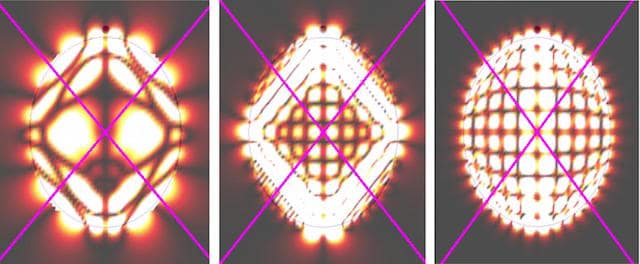In 2014, University of California, San Diego, physicist Michael Fogler and colleagues demonstrated that light could be stored within nanoscale granules of hexagonal boron nitride. Now Fogler’s research group has published a new paper in Nano Letters that elaborates how this trapped light behaves inside the granules.
The particles of light phonon polaritons are said to disobey standard laws of reflection as they bounce through the granules, but their movement isn’t random. Polariton rays propagate along paths at fixed angles with respect to the atomic structure of the material, Folger’s team said. That in turn can lead to “interesting resonances”.
“The trajectories of the trapped polariton rays are very convoluted in most instances,” Fogler said in a statement. “However, at certain…frequencies they can become simple closed orbits.”

When that happens clusters of strongly enhanced electrical fields can emerge. Fogler’s group found those could form elaborate geometric patterns in granules of spheroidal shape.
The polaritons are not only particles but also waves that form interference patterns. When overlaid on the hot contours of enhanced electrical fields, these create strikingly beautiful images.
“They resemble Fabergé eggs, the gem-encrusted treasures of the Russian tsars,” Fogler observed.
Beyond creating beautiful images, their analysis illustrates the way light is stored inside the material. The patterns and the frequencies are determined not by the size of the spheroid but its shape, or the ratio of its girth to length. The analysis revealed that a single parameter determines the fixed angle along which polariton rays propagate with respect to the surface of the spheroids.
Scientists are beginning to find practical uses for materials such as hexagonal boron nitride that manipulate light. The theory this work informed could guide the development of applications such as nanoresonators for high-resolution colour filtering and spectral imaging, hyperlenses for subdiffractional imaging, or infrared photon sources.
The analysis provides a theoretical explanation for earlier observations of trapped light. Fogler and colleagues suggest several experiments that could confirm their prediction of orbiting light using advanced optical techniques, some of which are underway.
“The experimental quest to detect orbiting polaritons has already begun,” said Fogler.










McMurtry Spéirling defies gravity using fan downforce
Ground effect fans were banned from competitive motorsport from the end of the 1978 season following the introduction of Gordon Murray's Brabham...